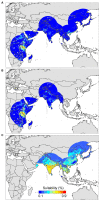Nairobi Sheep Disease Virus: A Historical and Epidemiological Perspective
- PMID: 32793646
- PMCID: PMC7387652
- DOI: 10.3389/fvets.2020.00419
Nairobi Sheep Disease Virus: A Historical and Epidemiological Perspective
Abstract
Nairobi Sheep Disease virus (NSDv) is a zoonotic and tick-borne disease that can cause over 90% mortality in small ruminants. NSDv has historically circulated in East Africa and has recently emerged in the Asian continent. Despite efforts to control the disease, some regions, mostly in warmer climates, persistently report disease outbreaks. Consequently, it is necessary to understand how environmental tolerances and factors that influence transmission may shed light on its possible emergence in other regions. In this study, we quantified the available literature of NSDv from which occurrence data was extracted. In total, 308 locations from Uganda, Kenya, Tanzania, Somalia, India, Sri Lanka and China were coupled with landscape conditions to reconstruct the ecological conditions for NSDv circulation and identify areas of potential disease transmission risk. Our results identified areas suitable for NSDv in Ethiopia, Malawi, Zimbabwe, Southeastern China, Taiwan, and Vietnam. Unsuitable areas included Democratic Republic of Congo, Zambia, and Southern Somalia. In summary, soil moisture, livestock density, and precipitation predispose certain areas to NSDv circulation. It is critical to investigate the epidemiology of NSDv in order to promote better allocation of resources to control its spread in regions that are more at risk. This will help reduce disease impact worldwide as climate change will favor emergence of such vector-borne diseases in areas with dense small ruminant populations.
Keywords: disease surveillance; ecological niche model; small ruminants; spatial distribution; systematic review; tick-borne.
Copyright © 2020 Krasteva, Jara, Frias-De-Diego and Machado.
Figures







References
-
- Kosgey IS Breeding Objectives and Breeding Strategies for Small Ruminants in the Tropics. (2004) Available online at: http://edepot.wur.nl/121527 (accessed March 15, 2019).
-
- Umunna MO, Olafadehan OA, Arowona A. Small ruminant production and management systems in urban area of southern guinea Savanna of Nigeria. Asian J Agric Food Sci. (2014) 2:107–14.
-
- Adams F. Socio-Economic Analysis of Small Ruminant Livestock Production in Northern Ghana. Socio-Economic Anal Small Rumin Livest Prod North Ghana. (2015). p. 1–200. Available online at: http://ir.knust.edu.gh/xmlui/bitstream/handle/123456789/9264/Faizal_Adam... (accessed March 15, 2019).
-
- FAO . Meat Market Review: 2019 Outlook. (2019). Available online at: http://www.fao.org/3/ca3880en/ca3880en.pdf (accessed April 10, 2020).
-
- Godiah LM, Baker D, Elmi II, Costagli R, Gulaid I, Wanyoike F. Enhancing the Provision of Livestock Marketing Information in Somaliland. Nairobi (2014) Available online at: https://cgspace.cgiar.org/bitstream/handle/10568/56737/ilriResearchRepor... (accessed March 17, 2019).
Publication types
LinkOut - more resources
Full Text Sources

